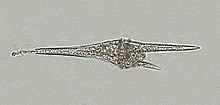
Back Dinoflagellate Afrikaans ዳይኖፍላጅላታ Amharic سوطيات دوارة Arabic سوطيات دواره ARZ Dinofit yosunlar Azerbaijani Динофитови водорасли Bulgarian Dinoflagelate BS Dinoflagel·lats Catalan Obrněnky Czech Dinoflagellater Danish
| Dinoflagellate | |
|---|---|

| |
| Ceratium furca | |
| Scientific classification | |
| Domain: | |
| Kingdom: | |
| Superphylum: | |
| Phylum: | Dinoflagellata Bütschli 1885
|
The dinoflagellates are a large group of flagellate protists. About half are photosynthetic, the rest are mostly heterotroph predators of other protists. The ones which are photosynthetic are sometimes loosely called 'algae'; the one which are predators are sometimes loosely called 'protozoa'.
They have been classified as an order, a class and a phylum by different authors. Research is being done on their relationships.
Most are marine plankton, but they are common in fresh water habitats as well. Their populations vary with sea surface temperature, salinity, and depth. The group includes many symbionts and bioluminescent species.
About 1,555 species of free-living marine dinoflagellates are described at present.[1] The latest estimates suggest a total of 2,294 living dinoflagellate species, which includes marine, freshwater and parasitic dinoflagellates.[2]
- ↑ Gómez F. 2005. "A list of free-living dinoflagellate species in the world's oceans". Acta Botanica Croatica. 64 (1): 129–212.
{{cite journal}}: CS1 maint: numeric names: authors list (link) - ↑ Gómez F. 2012. (2012). "A checklist and classification of living dinoflagellates (Dinoflagellata, Alveolata)" (PDF). CICIMAR Océanides. 27 (1): 65–140. doi:10.37543/oceanides.v27i1.111. Archived from the original (PDF) on 2013-11-27. Retrieved 2015-06-16.
{{cite journal}}: CS1 maint: numeric names: authors list (link)